#Librarie des Arts Décoratifs
Explore tagged Tumblr posts
Photo



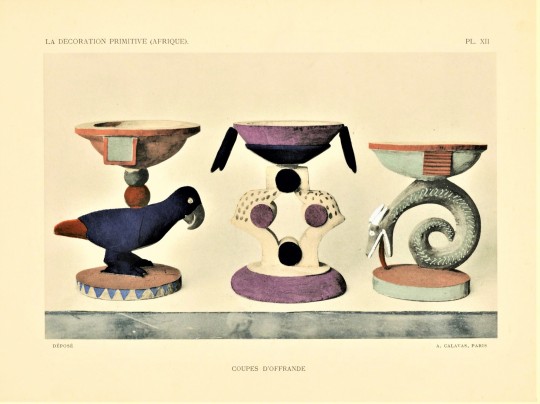

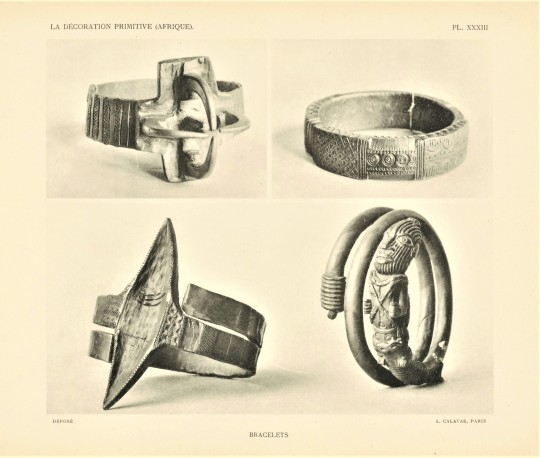




Decorative Sunday
This week’s plates are from the first volume of La Décoration Primitive, a collection of portfolios documenting the decorative art of Africa, Oceania, and the Americas (the last in two volumes, separated by pre- and post-Columbian). The four volumes were published in Paris by the photography and decorative arts publisher A. Calavas for Librarie des Arts Décoratifs, likely in 1922. The art critic and theorist Rosalind Krauss postulated that these volumes, along with Calavas’s other publishing for Librarie des Arts Décoratifs, were “published specifically for the instruction of arts and design students” in her 1985 work The Originality of the Avant-Garde and Other Modernist Myths.
While the Oceania and two American volumes contain introductory texts by Daniel Réal, a painter and curator at the Musée d'Ethnographie du Trocadéro, the text of La Décoration Primitive Afrique is by P.-C. Lepage. Lepage opens his introduction by addressing the use of the term “primitive,” insisting it is not used pejoratively. Indeed, “primitive art” was the most pervasive term used to describe non-Western art at the beginning of the 20th century. The term has declined in use as more of the art world has recognized the explicitly derogatory connotations. The rest of Lapage’s introductory text goes on to extoll the richness of the artistic tradition of the African continent, and laments the “disastrous influence” of les blanches in Africa, first by destroying “tout ce qui était à portée de leur ardeur iconoclaste (everything within reach of their iconoclastic ardor).”
-Olivia Hickner, Special Collections Graduate Intern
#Decorative Sunday#decorative plates#decorative arts#La Décoration Primitive#La Décoration Primitive Afrique#African art#African decorative art#A. Calavas#Librarie des Arts Décoratifs#Daniel Réal#P.-C. Lepage#Rosalind Krauss#Olivia
27 notes
·
View notes
Photo



09.07.2021
Ce matin, c’était bibliothèque, où j’ai fait des recherches sur l’actualité des musées en France, et où j’ai terminé une fiche d’histoire sur les institutions de la santé du Moyen Age à nos jours. Dans l’après-midi, j’ai visité le musée des Arts décoratifs pour réviser l’art médiéval (on n’en sort pas) et j’ai eu un coup de coeur pour ce musée! Je n’arrive pas à croire que je n’y étais jamais entrée en vingt ans. Il est magnifique. Je n’en ai même pas visité le tiers! Tellement hâte d’y retourner!
___
This morning I went to the library to do some research about the latest events in French museums, and I finished to study the history of hospitals and healthcare since the Middle Ages. I spent my afternoon in the museum of Decorative Arts to study more medieval art (because there’s always more to discover) and I had a literal crush on this museum. I can’t believe I never visited it before, it is so incredible and huge, I didn’t even saw half of it! I can’t wait to visit the rest of it!
#studyblr#french studyblr#history studyblr#history studies#museum studies#gradblr#studyspo#student life#notes#academia#dark academia
20 notes
·
View notes
Photo

INTERIOR SERIES - N°01
Rohan Palace’s Library, Musée des Arts Décoratifs, Strasbourg, France.
6 notes
·
View notes
Text
Modernism Evolving
Cover of the newly formed 1929 UAM catalogue.
This publication is one of many period resources in the Cooper Hewitt, Smithsonian Design Library have chronicling French Art Deco and the shift into modernism in the 20th century. The UAM (Union des artistes modernes) was founded in May 1929 by a group of French decorators, designers and architects led by Robert Mallet-Stevens who were disillusioned by the dominant aesthetics of 20th century design and work promoted by artists’ organizations like Société des Artistes-Décorateurs (SAD), started in 1901.
Architecture by Robert Mallet-Stevens
They sought to promote the decorative and applied arts as a profession with great value and benefit to the French economy and its reputation in fashionable design. Many of the artists and designers who joined the UAM had originally been members of the SAD artists who produced lavish and expensive luxury items for the affluent, as evidenced by some of the items displayed in 1925 Paris Exposition des Arts Décoratifs et Industriels.
Interior designed by Francis Jourdain
They wanted to break with some of the excessive ornament of the past and promoted simplicity and functionalism in design, using new materials, using manufacturing that suited the modern lifestyle. This catalog was the first presentation of the newly formed society, listing the members committed to their design principles, and featuring 24 examples of their designs and work. It has the original red- and black-printed cream colored thick paper cover, and glue binding. The UAM held their first exhibition the following year in 1930.. Members of the UAM in opposition to these principles included Charlotte Perriand, Le Corbusier, Sonia Delaunay, Jean Puiforcat, Franz Jourdain, René Herbst, Pierre Chareau, Eileen Gray and Louis Sognot.
Rings and necklace designed by Jean Fouquet.
They designed furniture, interiors, jewelry, glass and architecture. The UAM artists wanted to eliminate ornament and aimed for a leaner, more spare aesthetic that was functional and affordable for the modern everyman using less expensive materials. THE UAM held exhibitions every year except during the years of World War II, published manifestos in support of other avant-garde movements and disbanded in 1958. This small but not insignificant publication documents the evolution of the new design movement that was modernism.
Many of the UAM members work can be seen in the Cooper Hewitt Design Library’s collection of rare and unique 4,000 Therese Bonney photographs, 1925-1937 . Her photos document her personal observations of the life, architecture and design in Paris, 1925-39. Bonney personally knew many of the artist-decorators and architects of the UAM. The subjects of her photographs ranged from individual objects to interior settings to window displays to major building complexes and focused on the impact of modernism on European design.
Elizabeth Broman is a Reference Librarian at the Cooper Hewitt, Smithsonian Design Library.
from Cooper Hewitt, Smithsonian Design Museum https://ift.tt/395cv6p via IFTTT
4 notes
·
View notes
Photo

Happy National Library Shelfie Day!
Elegantly standing on the shelf are Encyclopédie des arts décoratifs et industriels modernes au XXème siècle. This twelve volume set documents Exposition internationale des arts décoratifs et industriels modernes held in Paris in 1925. Don’t they just look beautiful on the shelf?
Encyclopédie des arts décoratifs et industriels modernes au XXème siècle : twelve volumes documenting the Paris exhibition of 1925 New York; Garland, 1977. 12 v. : ill. ; 26 cm. French Notes Reprint of the ed. published by Impr. nationale, Office central d' éditions et de librairie, Paris. Includes original t.p.'s in French; text in French. Includes bibliographies and indexes. 1977 HOLLIS number: 990049000730203941
#nationallibraryshelfieday#shelfie#library#books#decorative arts#artsdecoratifs#fineartslibrary#harvardfineartslibrary#harvardfineartslib#Harvard#harvard library
22 notes
·
View notes
Video
instagram
HO’OPONOPONO NEW YEAR _ “Right now, we need writers who know the difference between production of a market commodity and the practice of an art. Developing written material to suit sales strategies in order to maximize corporate profit and advertising revenue is not the same thing as responsible book publishing or authorship. Yet I see sales departments given control over editorial. I see my own publishers, in a silly panic of ignorance and greed, charging public libraries for an e-book six or seven times more than they charge customers. We just saw a profiteer try to punish a publisher for disobedience, and writers threatened by corporate fatwa. And I see a lot of us, the producers, who write the books and make the books, accepting this — letting commodity profiteers sell us like deodorant, and tell us what to publish, what to write. Books aren’t just commodities; the profit motive is often in conflict with the aims of art. We live in capitalism, its power seems inescapable — but then, so did the divine right of kings. Any human power can be resisted and changed by human beings. Resistance and change often begin in art. Very often in our art, the art of words. My job is to keep the meaning completely embodied in the work itself, and therefore alive and capable of change. I think that’s how an artist can best speak as a member of a moral community: clearly, yet leaving around her words that area of silence, that empty space, in which other and further truths and perceptions can form in other minds.” The ever humble #UrsulaLeGuin. Story is context. Context is texture. Texture is fashion. Hoping 2019 will be intelligent social networking, and less crazy orneriness; be elevated creativity and less buzz just to make people talk; be true art, less greed. A year ago, #ChristianDiorAD’ 70 years of @Dior’s lavishnesses were celebrated in a grandiose scenography by Nathalie Crinière @MADParis with curators @Olivier_GABET, #ArtsDecoratifs Museums Director and @FlorenceMuller99, Avenir Foundation Curator of Textile Art and Fashion, @DenverArtMuseum. We, indeed, are in a dire need of a neo breed. Couturiers, du rêve. _ #ALESSANDROBERGA | L’ÉDITOR #PARIS #MODEDIPLOMATIQUE (at Musée des Arts décoratifs) https://www.instagram.com/p/BsTS7aIAcCe/?utm_source=ig_tumblr_share&igshid=1smcwtvrag8o1
1 note
·
View note
Photo

« À la rencontre du petit prince » est une exposition fleuve présentée par le musée des Arts décoratifs jusqu’au 26 juin. Elle aurait dû s’intituler « à la rencontre de Saint Exupéry » puisque le musée nous entraîne à la découverte de l’écrivain, du poète, de l’aviateur, du combattant, de l’humaniste et du philosophe. Au travers de 600 documents dont de nombreux dessins et beaucoup d’écrits, malheureusement difficiles à lire en cas de forte affluence, les deux commissaires de l’exposition montrent l’émergence progressive du petit prince dans l’oeuvre de Saint Exupéry. C’est en toute logique que le manuscrit original du petit prince, conservé à la magnifique Morgan Library & Museum de New York, et jamais présenté en France, constitue l’apothéose de l’exposition. Le célèbre livre traduit en presque 500 langues et dialectes est la synthèse d’une vie tournée vers l’action. Il constitue un message d’espoir humaniste destiné à sensibiliser ses contemporains, comme les générations futures, à la menace qui pèse sur une humanité trop oublieuse d'elle-même, devenue incapable de saisir l'essentiel et la beauté de sa condition. Au regard de l’évolution du monde, Saint Exupéry apparaît, aujourd’hui, visionnaire. En ces temps troubles, gardons en tête le propos du renard : « on ne voit bien qu’avec le cœur. L’essentiel est invisible pour les yeux ». Précisons que l’exposition n’est pas faite pour les enfants mais pour les adultes qui ont gardé en eux une part d’enfance. Vous appréciez mes idées de sorties culturelles ? Choisissez votre prochaine exposition en vous abonnant à mon compte Instagram paris_aimelart @madparis @lepetitprinceofficiel @antoinedesaintexupery_officiel @themorganlibrary #antoinedesaintexupery #antoinedesaintexupéry #lepetitprince #museedesartsdecoratifs #muséedesartsdécoratifs #museedesartsdecoratifsparis #morganlibrary #pierpontmorganlibrary #parisaimelart #paris_aimelart #parisexpos #parisexposition #parismusees #exposparis #paris #exposition #parisculturel #quefaireaparis (à Musée des Arts décoratifs) https://www.instagram.com/p/Ca77D8GrzhK/?utm_medium=tumblr
#antoinedesaintexupery#antoinedesaintexupéry#lepetitprince#museedesartsdecoratifs#muséedesartsdécoratifs#museedesartsdecoratifsparis#morganlibrary#pierpontmorganlibrary#parisaimelart#paris_aimelart#parisexpos#parisexposition#parismusees#exposparis#paris#exposition#parisculturel#quefaireaparis
0 notes
Text
À LA RENCONTRE DU PETIT PRINCE Jusqu’au 26 juin 2022

Le Musée des Arts Décoratifs présente la première grande exposition muséale en France consacrée au Petit Prince, chef-d’œuvre intemporel de la littérature. Plus de 600 pièces célèbrent les multiples facettes d’Antoine de Saint-Exupéry : écrivain, poète, aviateur, explorateur, journaliste, inventeur, philosophe, porté toute sa vie par un idéal humaniste, véritable moteur de son œuvre.
À l’occasion de cet hommage exceptionnel, le manuscrit original, conservé à la Morgan Library & Museum à New York et jusqu’alors jamais présenté au public français, est mis en regard d’aquarelles, esquisses et dessins – pour la plupart inédits – mais également des photographies, poèmes, coupures de journaux et extraits de correspondances.
Le Petit Prince, dernier ouvrage édité du vivant de Saint-Exupéry, écrit et publié aux États-Unis en 1943 mais paru en France en 1946, est depuis lors un succès qui traverse les frontières et les époques, porteur d’un message universel.
Billetterie : https://billetterie.madparis.fr/catalogue_activites?site=0&exposition=0&typ_prest=1&langue=0
0 notes
Photo

A la rencontre du petit Prince. Musée des Arts Décoratifs. 107 Rue de Rivoli, 75001 Paris. Du 17 Février jusqu'au 26 juin 2022 Le Musée des Arts Décoratifs présente la première grande exposition muséale en France consacrée au Petit Prince, chef-d'œuvre intemporel de la littérature. Plus de 600 pièces célèbrent les nombreuses facettes d'Antoine de #SaintExupéry : #écrivain, #poète, #aviateur, #explorateur, #journaliste, #inventeur, #philosophe, porté toute sa vie par un idéal #humaniste, véritable moteur de son œuvre. À l'occasion de cet hommage, le manuscrit original, conservé à la Morgan Library & Museum à New York et jusqu'alors jamais présenté au public français, est mis en regard d'aquarelles, esquisses et dessins - pour la plupart inédits. ————— Meet the Little Prince. Arts Museum Decorative. 107 Rue de Rivoli, 75001 Paris. From 17 February until June 26, 2022 The Museum of Decorative Arts presents the first major museum exhibition in France devoted to Little Prince, timeless masterpiece of literature. More than 600 pieces celebrate the multiple facets of Antoine de #Saint-Exupéry: writer, poet, #aviator, #explorer, #journalist, #inventor, #philosopher, driven all his life by an ideal humanist, real driving force behind his work. On the occasion of this exceptional tribute, the original manuscript, held at the Morgan Library & Museum in New York and hitherto never presented to the French public, is placed next to watercolours, sketches and drawings - mostly unpublished - corn also photographs, poems, clippings of journals and excerpts of correspondence. The #PetitPrince, the last work published during the lifetime of Saint-Exupéry, born in 1900 died in 1944, wrote and published in the United States in 1943 but published in France in 1946, has since then been a success that crosses the borders and eras, carrying a message universal.— #MAD#Pariis #lepetitprince #musée #Loveparis #battini #battiniparis #jeanlucbattini #art #exposition #littleprince #france #photos #photography (à Musée des Arts décoratifs) https://www.instagram.com/p/CaNJUw1oWKU/?utm_medium=tumblr
#saintexupéry#écrivain#poète#aviateur#explorateur#journaliste#inventeur#philosophe#humaniste#saint#aviator#explorer#journalist#inventor#philosopher#petitprince#mad#pariis#lepetitprince#musée#loveparis#battini#battiniparis#jeanlucbattini#art#exposition#littleprince#france#photos#photography
0 notes
Text
LA / Cosmic Trace

Mary Beth Heffernan, Ashes (Foot 1) (Amy Lyford and Jean Thomas Lyford), Human cremains, unique gelatin silver photogram, 11" x 14", 2019
Cosmic Trace February 12 - March 5, 2022 Opening reception: Saturday, Feb 12, 2022 7-10 pm
[Image List] [Watch Artist Talk]
Since the beginning of time humans have attempted to make sense of the world and our place in it through a variety of thought processes including art, science, religion, and material explorations across all media.
Tiger Strikes Asteroid is proud to present Cosmic Trace, a four-person exhibition that explores ideas of the body and our relationship to the world through a spectrum of materials and methodologies. Art practices that dip in and out of magic and science to grapple with how we illustrate and decipher meaning. The exhibition includes a selection of works by Mary Beth Heffernan, Mary Little, Astri Swendsrud and Melissa Walter.
In Cosmic Trace, we see four contemporary makers step through a range of portals in search of meaning. Mary Beth Heffernan explores questions of physicality and representation in her exquisite photograms, observing "like the photograph itself, cremains are an alchemic state suspended between presence and absence." Melissa Walter explores representations of the body through sensitive minimalist drawings that reference DNA coding, while at the same time remaining mindful not to completely obscure the artist’s touch and the beauty of the handmade. In the work of Mary Little, minimalist abstraction, landscape and the body collide conceptually and coalesce into a gravitational dance of light, surface, and pattern in her fabric wall installations. Finally, the idea of patterns, wavelengths and the various conceptual and psychological tensions created by the search for meaning in a seemingly chaotic world are deftly rendered in The Receiver sculptures presented by Astri Swendsrud. Within the varied processes there is a sympathetic magic to the way these four artists' bodies of work dance around similar regions of thought that perhaps get us just a little closer to an understanding of our place within this universe.
________
Mary Beth Heffernan is a Los Angeles-based artist whose work explores the interplay of corporeality and images. She earned her MFA in Photography at the California Institute of the Arts, and was a Studio Fellow of the Whitney Independent Study Program. Heffernan is currently Professor of Sculpture, Photography and Interdisciplinary Art at Occidental College. In 2019 Heffernan’s lauded PPE Portrait Project was put on permanent exhibit at the Welcome Collection in London. She was awarded the inaugural 2016-7 PAC/LA Contemporary Artist Grant as Artist-in-Residence at The Huntington Library. In 2010, Heffernan earned the COLA Master Artist Fellowship. Her work has been supported by grants from the Photographic Arts Council/LA, the Arnold P. Gold Foundation, the Los Angeles Department of Cultural Affairs, the Durfee Foundation, and Light Work. Heffernan’s work has been reviewed in The Times (London,) the LA Times, the San Francisco Chronicle, National Public Ratio, Public Radio International, CSNBC, LA Review of Books, the LA Weekly, Hyperallergic, Art Papers, Art Issues, and pictured in the New York Times. Heffernan’s art is included in numerous private and public collections, including The Huntington Library, Arts Collections, and Botanical Gardens, the Hammer Museum Grunwald Center Collection, the Los Angeles County Museum of Art, Light Work of Syracuse, NY, and the New York City Library.
marybethheffernan.com @marybethheffernanstudio
Mary Little was born in Northern Ireland and moved to the United States in 2001 to take up a teaching position at California College the Arts (CCA), San Francisco. Trained as a furniture designer at London’s Royal College of Art, she has always approached her work as sculpture. Her work is in the permanent collections of the Vitra Design Museum in Basel and Musée des Arts Décoratifs, Paris. Her commissions and gallery works have been acquired for private collections in Europe and North America, as well as public collections including the Victoria & Albert Museum, London. Little's work has most recently been reviewed in Architectural Digest, Galerie, and Surface magazines. She is a 2019 recipient of the prestigious Pollock-Krasner Foundation Grant and lives in Los Angeles.
marylittle.com @marylittlestudio
Astri Swendsrud is a Los Angeles-based artist whose multi-disciplinary practice investigates the formation of meaning, belief, interpretation and transformation. Her work has been exhibited in solo and group shows nationally, including JOAN, Visitors Welcome Center, Richard Telles Fine Art, General Projects and the Vincent Price Museum, Swendsrud is also part of the collaborative project Semi-Tropic Spiritualists, and their book The Semi-Tropic Spiritualist's Guidebook was published by Insert Blanc Press in 2018. Swendsrud is a co-founder and co-director of Elephant Art Space in Los Angeles, and she is Associate Professor of Art at Biola University. She received her MFA from CalArts in 2008.
astriswendsrud.com @alswendsrud
Melissa Walter is best known for her optically stimulating sculptures of twisting paper and drawings of detailed geometric patterns, Walter visually explores concepts concerning Astronomy and astrophysical theories. Walter has worked as a graphic designer and science illustrator for NASA’s Chandra X-ray Observatory and as a team member of the Harvard-Smithsonian Center for Astrophysics. Her experience has inspired her to visually articulate wonders of the Universe, such as black holes, supernovas, neutron stars, dark matter and more recently, dark energy. Walter has recently completed an artist in residence program at Bread & Salt and participated in exhibitions at the San Diego Art Institute, Torrance Art Museum, Helmuth Projects and the San Diego International Airport for a temporary exhibition titled Intergalactic Dreaming in 2017. She received her BFA, cum laude from the University of Rhode Island in 1998.
melissawalterart.com @_melissa.walter_
























photos by Gemma Lopez
0 notes
Photo
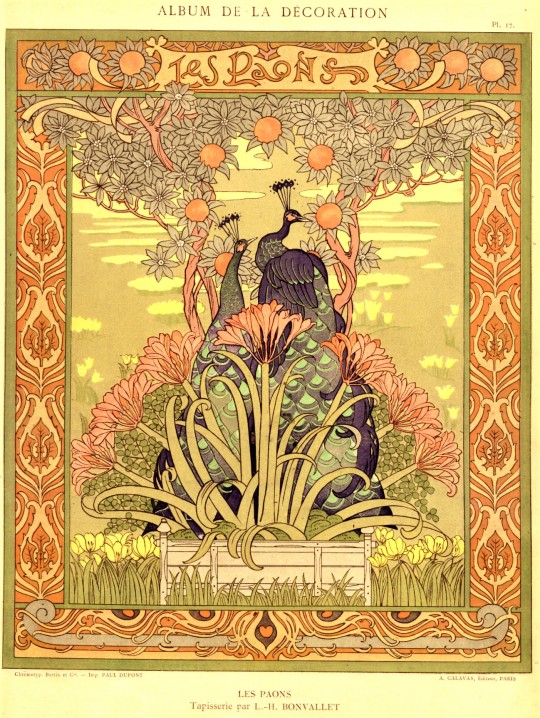


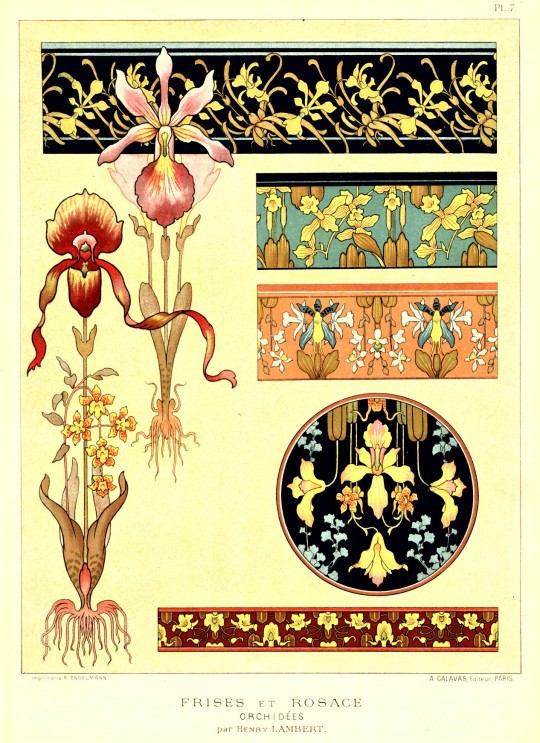

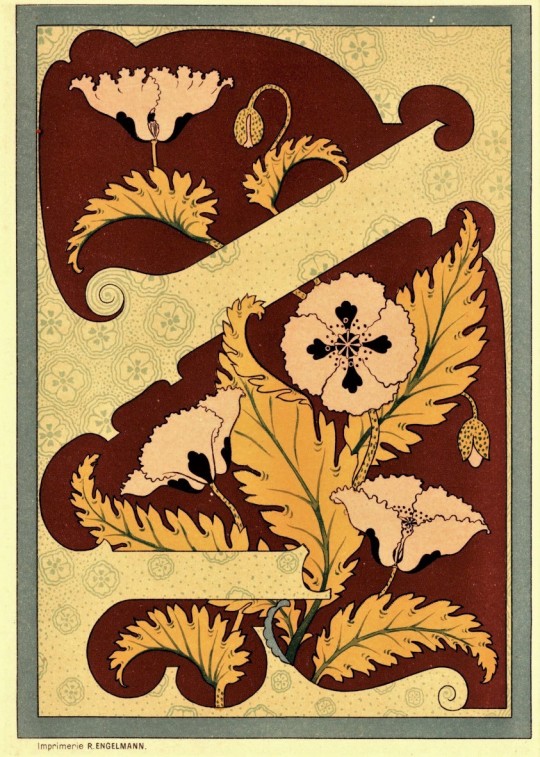
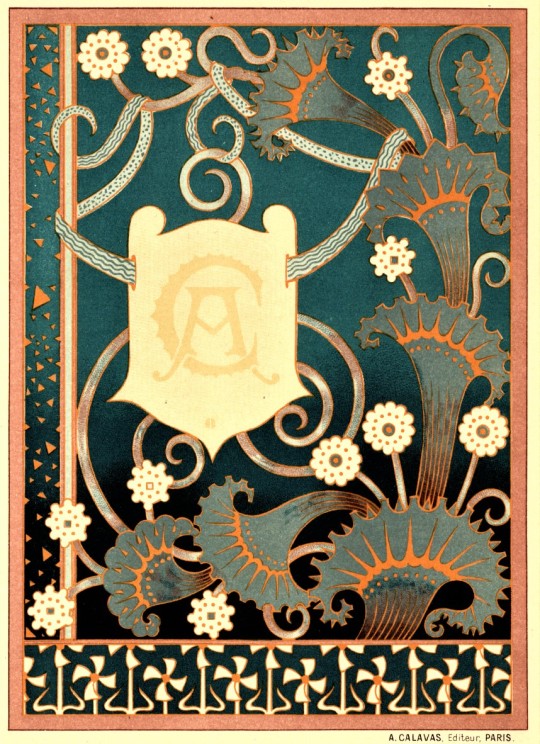
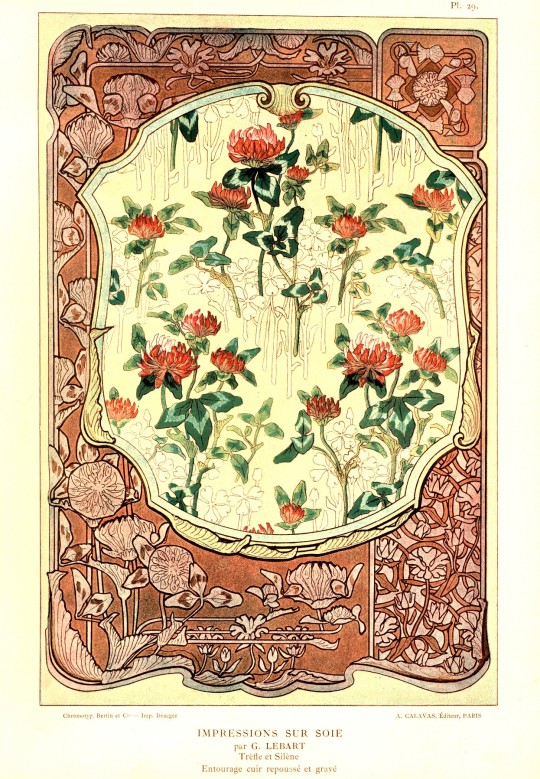
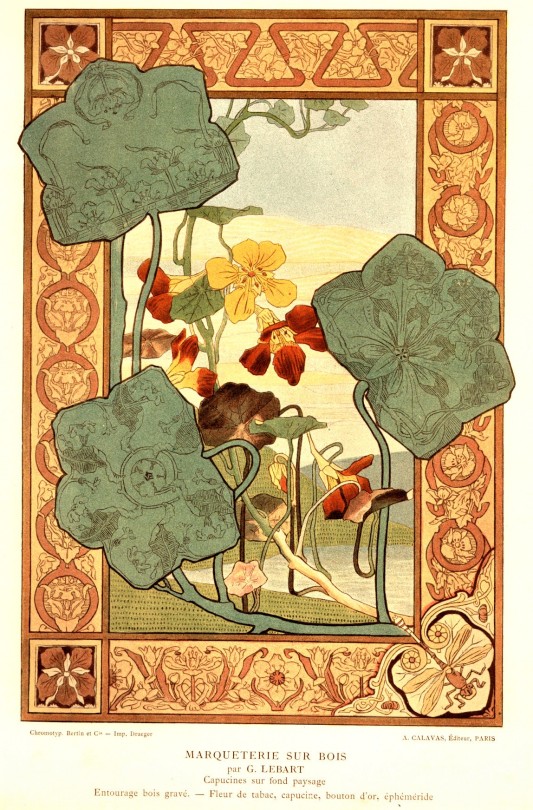
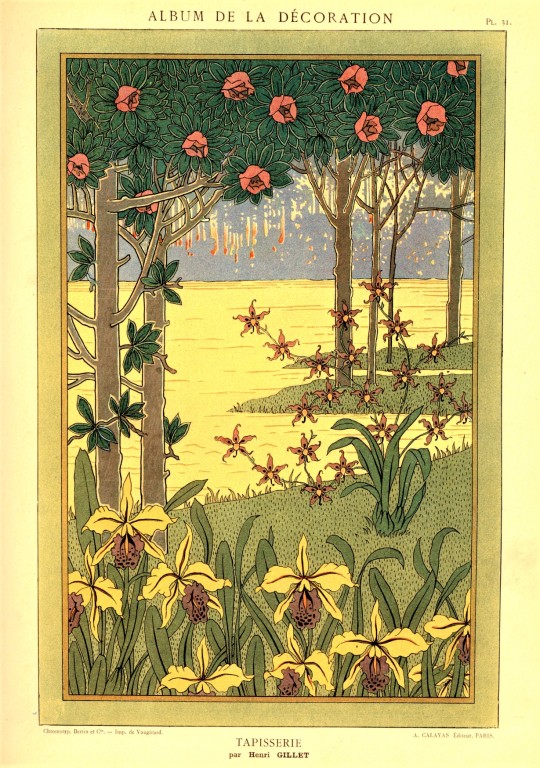
Decorative Sunday
Album de la décoration from Milwaukee Public Library
This week we are highlighting a beautiful Art Nouveau decorative art portfolio held by our friends over at Milwaukee Public Library’s Central Library. It is titled Album de la décoration edited by A. Calavas, published in 1900 in Paris by Librairie des Arts décoratifs. This portfolio features beautiful floral motifs that would have been used as inspiration for designers of various decorative objects like textiles, tapestries, ceramics, wallpaper, and paintings. There were many artists that contributed to the portfolio, including L. H. Bonvallet, Henry Lambert, Henri Gillet, and G. Lebart.
A sampling of illustrations from Album de la décoration can be found online at MCAD Library’s Flickr account.
If you are local to the Wisconsin you can see all three volumes of Album de la décoration in person at Milwaukee Public Library’s Central Library. Their MPL Special Collections department also recently started an Instagram account to highlight materials from their extensive collections including art, rarities, local history, and archives. Give them a follow at mplspecialcollections on Instagram!
View other Decorative Sunday posts.
–Sarah, Special Collections Senior Graduate Intern
#Decorative Sunday#Album de la décoration#Milwaukee Public Library#Art Nouveau#Paris#French#decorative plates#decorative arts#ornament#A. Calavas#L. H. Bonvallet#Librairie des Arts décoratifs#Henry Lambert#Henri Gillet#G. Lebart#mplspecialcollections#MPL Special Collections#art portfolio#decorative art#decoration#floral#botanical art#color lithography#peacock#Sarah Finn#sarah
1K notes
·
View notes
Photo

BACK IN THE BOOKSHOP: LES LALANNE (1984) Hardcover monograph on the work of Les Lalanne (Claude Lalanne & Francois-Xavier Lalanne) on the occasion of a major exhibition of their work at Christian Fayt Gallery in Belgium 11.8-16.9, 1984. Introduction by Daniel Abadie (in French) and reproductions in colour of many of their most notable, incredible sculptural objects. Les Lalanne are a French artist duo comprising married couple François-Xavier Lalanne (1927–2008) and Claude Lalanne (born 1924). Francois-Xavier Lalanne was born in Agen, France, and at age 18, he moved to Paris and studied sculpture, drawing and painting at Académie Julian. Francois-Xavier rented a studio in Montparnasse, next door to friend Constantin Brâncuși, who introduced Lalanne to artists such as Max Ernst, Man Ray, Marcel Duchamp, and Jean Tinguely. He met Claude Lalanne at his first gallery show in 1952. The show signified an end of painting for François-Xavier as he and Claude began their career sculpting together. Claude Lalanne (b. 1924) was born in Paris and studied architecture at the École des Beaux-Arts and at the École des Arts Décoratifs. The couple began attracting public attention in Paris during the 1960s when Yves Saint Laurent and Pierre Bergé commissioned them - in particular, Francois-Xavier's realistic bronze cast sheep covered in skin alongside lily vanes cast by Claude were displayed in the library for their library. Francois-Xavier Lalanne became known to the larger public in France in 1976 when the singer Serge Gainsbourg selected a work by Lalanne, the man with the head of a cabbage, for the title and cover of an album in 1976. Together Les Lalanne were known to co-create on projects rather than collaborate. While Francois-Xavier favored sculpting animal themes, Claude preferred vegetation. The themes explored by the two collectively went against the current trend of Abstract art in the 1960s. The couple believed and Francois-Xavier claimed, "the supreme art is the art of living." One copy in the bookshop and via our website. #worldfoodbooks #leslalanne #1984 (at WORLD FOOD BOOKS)
57 notes
·
View notes
Photo

Now on view in our current exhibition are plates from Sonia Delaunay’s Sonia Delaunay, ses peintures, ses objets, ses tissus simultanés, ses modes. Paris: Librairie des Arts Décoratifs, [1925]. Rare Book Collection, University of Chicago Library.
#women artists#frenchdesign#french artist#rarebooks#UChicago Arts#uchicago#specialcollections#fashiondesign#decorative arts
7 notes
·
View notes
Text
NIPPON

Fabricants de lanternes en papier dites chōchin peignant, début du xxe siècle - © New York Public Library - D. R.
Le madd-bordeaux consacre une exposition à un mode d’éclairage devenu, au fil des siècles, constitutif de l’identité culturelle du Japon et dont la fabrication a été reconnue « artisanat traditionnel » par le ministère de l’Économie, du Commerce et de l’Industrie. Il s’agit des chōchin, ces lanternes constituées d’une structure en bambou recouverte de papier, que la légèreté semble condamner à une vie éphémère. À travers objets, estampes, photographies et films, l’exposition présente leur fabrication et l’évolution de leur usage, leur place dans la mythologie et les rituels japonais, et leur adoption par les designers depuis les années 1950.
« As movable as butterflies - Les chōchin du Japon », jusqu’au dimanche 19 mai, musée des Arts décoratifs et du Design. madd-bordeaux.fr
#En Bref#As movable as butterflies#Les chōchin du Japon#musée des Arts décoratifs et du Design#Mars 2019
0 notes
Text
Exhibitions in Paris
Being known as the city of lights, Paris has a formidable history associated with culture and entertainment. It’s daunting heritage, museums, libraries, monuments and exhibitions are a delight for the eyes. The city has been a residence of world’s most renowned artist from the biblical times. The richness and purity this city possesses in terms of art and culture is unparalleled. The city is also France’s capital, which makes it even more important in terms of global affairs. Paris is also a home to various business and political events. A lot of fairs and exhibitions are held within the city every now and then. The city hosts these events proudly and promptly as well.
Art and culture of Paris
Paris attracts millions of visitors and tourists every year. The main factor behind being such a tourist eye candy is the fact that the city is filled with attractive places to visit and the culture is a magnet for the tourists as well. Here is a list of museums and art galleries in Paris that represent the city’s love and enthusiasm for its history and culture.
· Musée du Louvre is a masterpiece that represents the art of medieval times. The museum is filled with antiques of the renaissance period, Egyptian mummies, and baroque paintings. Art exhibitions are held at the Musée des Arts Décoratifs and you can book a ticket online or get it from the agency as well.
· Musée d'Orsay was since a train station but now it has been a home to world’s greatest arts and antiques. The top and down floor are beautifully and symmetrically arranged with the antiques and the masterpieces. You can visit the exhibitions easily. All you have to do is buy a ticket or book it online as well.
· Musée Marmottan-Claude Monet is a museum, which is filled with the paintings and impressions of the great artist of all times, Monet. The place is a must visit in Paris.
Exhibitions in Paris
Paris is a city that lives among all the happiness and crowdedness. The city is filled with people all around the year due to the countless fairs and exhibitions. You can attend some of the art exhibitions in Paris at the art galleries and museums as listed above. Some of the events are held yearly. So, have a brief look at the events that you can attend in this in 2017. Book your tickets before it is too late for you to visit the Paris art exhibition 2017:
· Mois de la Photo is a photography exhibition that is held in November every year. But this year it is going to be held in the spring season. You can see the works of greatest world photographers such as Takashi Arai, Walker Evans, Stephane Duroy, Space Oddity by Stanley Kubrick and JR at Palais de Tokyo. Have a visit if you are in Paris by the end of this May.
· Exhibitions in Paris has a great history and here is an inclusion to this list. Nuit des musées is an exhibition for the art lovers in Paris. It will be held on 20th May 2017. You can visit Louvre, Musée de Orsay and other museums without spending a single buck on the tickets. Yes! It is free of cost and is open to the public.
· Paris events 2017 also have an exhibition at the Musée Picasso. The event is named as Olga Picasso and it is all about the painter’s life and relationship with his wife Olga. The event is in the process since March 2016- September 2017. Grab your tickets and get to know your favorite painter a little better.
· L'Esprit français - Contre-cultures in France 1969-1989 is an event, which is held from February to May 2017. The exhibition depicts the struggle and history of France through paintings.
· Petit Palais also playing its part in the Paris events by organizing an event named as De Watteau à David, la collection Horvitz. The exhibition has about 200 paintings of Watteau, Boucher and other French artists, which are brought under a single roof by Horvitz. The event will be held until the end of July 2017. · Auguste Rodin at Grand Palais is an exhibition of the sculptures of Auguste Rodin at his 100th
Anniversary. Grand Palais is proudly hosting this event. It is held until the end of July this year. You can visit it now since it is still going on. The art exhibitions in Paris are a delight to watch. Grab the tickets before you miss out on some of the marvellous events held in Paris this year.
1 note
·
View note
Text
Shopping for Art Deco in an Art Deco Paris
On display in Cooper Hewitt’s The Jazz Age: American Style in the 1920s Jazz Age exhibition is the Design Library’s René Herbst’s Store windows, vitrines, shop installations for the l’Exposition Internationale des Arts Decoratifs, Paris, 1925.
The “Exposition Internationale des Arts Décoratifs et Industriels Modernes” established Paris as the city to sell the new design and aesthetic of Art Deco. Storefront architecture and displays both created and promoted this style as part of the city streetscape.
Galerie des Boutiques Françaises. Sauvage, architecte. Pl. 39
The Pont Alexander III Bridge, which connected the two parts of the Exposition, was turned into a modernist shopping mall by the architect Maurice Dufrêne. The Bridge and on the street of Galerie des Boutiques, exclusive shops promoted luxury goods with carefully staged and designed window displays. The banks of the Seine were lined with floating restaurants built for the Exposition, which became a popular attraction.
René Herbst, (1891-1982) author of this image collection, was an interior decorator and furniture designer, and had a shop himself, Établissements René Herbst. At the 1925 Exposition he created several shop windows on the “rue des boutiques” on the Pont Alexandre-III Bridge. The window displays and exterior facades of these shopping showcases utilized iconic Art Deco design elements. Large department stores such as Le Printemps, les Galeries Lafayette, and Au Bon Marché, seen in the images below and which are still in business today, all participated in this massive Art Deco merchandise promotion.
Le Printemps. Sauvage et Georges Wybo, architects Pl. 42.
Les Galeries Lafayette, Exposition des vitrines exteriéures. Jean Hiriart, Georges Tribeau et Georges Beau, architects. Pl. 41.
Le Bon Marché. Intérieur. L.-H. Boileau, architecte; Paul Follot, décorateur. Pl.40
The department stores had their own design and decorating consulting services that promoted the works of well known interior decorators, textile, wall covering, lighting and furniture, glass and ceramic designers. The “Studium-Louvre,” was a modern decorative art workshop in the department stores of the Louvre. The smaller boutiques and specialty shops sold specialty products such as furniture and other furnishings, textiles, clothing, fashion accessories, leather, jewelry and other decorative arts items.
Le Studium au Louvre. A. Laprade, architecte; Binquet, sculpture decorative; Edgar Brandt, ferronerie (ironwork). Pl. 43
See this object in The Jazz Age: American Style in the 1920s, on view until August 20, 2017.
Elizabeth Broman is Reference Librarian at Cooper Hewitt, Smithsonian Design Library.
from Cooper Hewitt, Smithsonian Design Museum http://ift.tt/2ovbPCn via IFTTT
1 note
·
View note